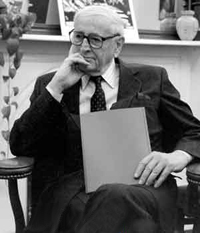John W. Gardner facts for kids
Quick facts for kids
John Gardner
|
|
|---|---|
 |
|
| 6th United States Secretary of Health, Education, and Welfare | |
| In office August 18, 1965 – March 1, 1968 |
|
| President | Lyndon B. Johnson |
| Preceded by | Anthony J. Celebrezze |
| Succeeded by | Wilbur J. Cohen |
| Personal details | |
| Born |
John William Gardner
October 8, 1912 Los Angeles, California, U.S. |
| Died | February 16, 2002 (aged 89) Palo Alto, California, U.S. |
| Resting place | San Francisco National Cemetery |
| Political party | Republican |
| Spouse | Aida Gardner |
| Education | Stanford University (BA) University of California, Berkeley (MA, PhD) |
| Awards | Presidential Medal of Freedom (1964) Public Welfare Medal (1966) |
John William Gardner (born October 8, 1912 – died February 16, 2002) was an important American leader. He served as the Secretary of Health, Education, and Welfare (HEW) for President Lyndon B. Johnson. He was known for encouraging people to get involved in their communities. He even started an organization called Common Cause. Many people called him "the father of campaign finance reform" because he worked to make political campaigns fairer. Interestingly, he was the only Republican in President Johnson's cabinet.
| Top - 0-9 A B C D E F G H I J K L M N O P Q R S T U V W X Y Z |
John Gardner's Early Life and Education
John Gardner grew up in California. He went to Stanford University for his college studies. While there, he was a talented swimmer, setting records and winning many championships. He graduated with excellent grades. After Stanford, he earned his Ph.D. in Psychology from the University of California, Berkeley in 1938. He then taught at Connecticut College and Mount Holyoke.
Military Service During World War II
During World War II, John Gardner helped the country. He first worked for the Foreign Broadcast Intelligence Service. Later, he joined the United States Marine Corps. He was assigned to the O.S.S., which was an intelligence agency. He served in countries like Italy and Austria during the war.
John Gardner's Career Before Government
After the war, John Gardner joined the Carnegie Corporation of New York in 1946. This was an important organization that supported education and research. By 1955, he became its president. He also led the Carnegie Foundation for the Advancement of Teaching.
He advised the U.S. team at the United Nations. He also worked as a consultant for the U.S. Air Force, which gave him an award in 1956. John Gardner was a leader in many areas. He was a trustee for the Metropolitan Museum of Art and the Educational Testing Service. He also helped lead the Rockefeller Brothers Fund Panel on Education. He wrote a famous report for this group called The Pursuit of Excellence.
Gardner wrote books about how to improve leadership in America. He also created two special programs for young leaders. These were The White House Fellows and The John Gardner Fellowship at Stanford University and U.C. Berkeley. In 1964, he received the Presidential Medal of Freedom, a very high honor. He also received the Public Welfare Medal in 1966 from the National Academy of Sciences.
Secretary of Health, Education, and Welfare
John Gardner became the Secretary of HEW during a time when President Johnson was working on his "Great Society" plans. These plans aimed to improve life for many Americans.
Key Achievements as Secretary
During his time as Secretary, Gardner's department launched Medicare. This program helped senior citizens get quality health care. His department also greatly expanded the Elementary and Secondary Education Act of 1965. This law changed how the federal government supported education. It sent money to schools, especially those with students from low-income families.
John Gardner decided to leave his role as Secretary because he did not agree with the Vietnam War. In 1967, he was featured on the cover of Time magazine. Later that year, he also helped create the Corporation for Public Broadcasting. This organization supports public television and radio.
John Gardner's Later Life and Legacy
After leaving government, John Gardner continued to be a public servant. He served on the Stanford University Board of Trustees from 1968 to 1982.
Founding Common Cause and Other Initiatives
On August 18, 1970, Gardner started Common Cause. This group works to make government more open and accountable. In the same year, he also founded the Experience Corps. This program helps older adults volunteer in their communities.
In 1973, he received an award for his great public service as a private citizen. He also helped start Independent Sector in the early 1980s. This group works to support non-profit organizations.
In September 2000, a center at Stanford University was named after him: the John W. Gardner Center for Youth and Their Communities. This center helps young people and their communities grow.
John Gardner passed away from cancer in San Francisco on February 16, 2002. He was buried in the San Francisco National Cemetery.
The John Gardner Fellowship Program
The John Gardner Fellowship Program was created in 1985 by Stanford University and the University of California, Berkeley. It was made to honor John Gardner's work. This fellowship encourages college seniors to work in public and community service.
Each year, three students from each university are chosen. They receive help finding a job, money to live on, and a mentor. Past fellows have worked in places like the White House and the United States Department of State.
Some well-known former fellows include Rachel Maddow and Heather Podesta.
Publications
John Gardner wrote several books sharing his ideas on leadership and society:
- Excellence: Can We Be Equal and Excellent Too? (1961)
- Self-Renewal: The Individual and the Innovative Society (1964)
- No Easy Victories (1968)
- The Recovery of Confidence (1970)
- In Common Cause (1972)
- On Leadership (1990)


